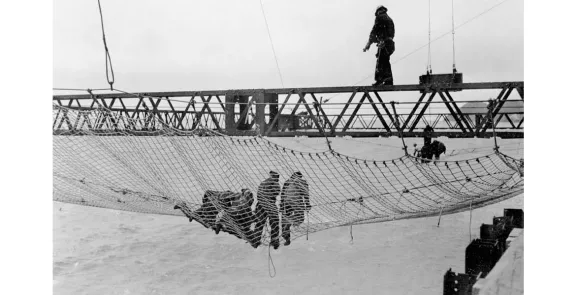
Our Own Private Halfway-to-Hell Club
“I thought being a psychiatry resident meant that I might lose a patient to suicide, but didn’t think I would lose a friend.”
As I overlook the Golden Gate Bridge from the Parnassus Library’s theater-style window seating, I mull over these words from Matthew Goldman, MD, MS, a recent UCSF School of Medicine alumnus who moved across the country to the skyscrapers of New York City for residency.
Bridges, libraries and high-rises — they are marvels of human achievement and icons of our incessant striving for land and territory, knowledge and scholarship, innovation and urbanism. But through certain sets of life-weary eyes, their great architectural heights do not evoke the high points of human accomplishment, but rather a hard logic that jumping from those distances might achieve a quick and final end to an often long and lonesome battle with the lows of depression, the highs and lows of bipolar, or the highs, lows and cyclone swirls of a psychotic disorder.
The Golden Gate Bridge is an infamous site for suicides (with a record 46 people jumping to their deaths in 2013, which helped push bridge officials to approve a $76 million dollar funding package the next year to build a steel net suicide barrier, finally slated to begin construction this July).
The main library on the NYU campus has been the site of three student suicides (two in 2003 and another in 2009, even after the university installed Plexiglas barricades to cover the culprit design feature: open-air crosswalks overlooking the central atrium).
Though the skyscrapers of New York may be more famously tied to the deaths of debt-laden bankers, they have recently played a part in the deaths of a few of the city’s young doctors. In the same week in late August 2014, two 20-something medical interns — both just two months into their respective programs — jumped from two different buildings in the Big Apple in apparent suicides.
One of those young men was Matt’s friend and roommate. More recently, the website of Dr. Pamela Wible, a leading voice in the movement to bring physician and medical student suicides to light, reports another possible resident suicide at a building owned by a third New York hospital system in March of this year.
With my gaze still fixed on the Golden Gate Bridge, my thoughts move from the jumpers to the bridge builders. The fierce and famous winds and fog they gritted against to get it done. The monumental passage they built over potent ocean currents and the lessons they learned in daring to do so. One of the occupational safety innovations created for the Golden Gate Bridge’s construction was a movable safety netting placed beneath active construction areas, which saved the lives of 19 otherwise-unprotected steelworkers, who then became part of the Halfway-to-Hell Club.
Falls are an obvious occupational hazard at construction sites, and nets are a common sense safety measure to prevent their worst consequences.
From here in this library overlooking this famous bridge, surrounded by the high-rise hospital buildings of UCSF medical center, I wonder:
Is poor mental health a similarly obvious occupational hazard in health care work? And, if so, what prevention measures could we easily put into practice?
What would a mental health safety net look like for health workers that might have helped catch these distressed residents long before they fell to their deaths?
For Matt, the answer is a clear yes. His first-hand experience of a health care never-event, like trainee suicide, added to his drive to boldly envision and advocate for the mental health-related occupational safety and wellness of physicians. He has presented to the Accreditation Council for Graduate Medical Education and penned a widely-circulated piece in JAMA Psychiatry entitled “Depression and Suicide Among Physician Trainees: Recommendations for a National Response.”
Matt admits (and reveals his psychodynamic therapy training in saying so) that part of his psychological response to the tragic loss of a friend was to “sublimate my feelings from that experience by getting very involved in the systems” that surround and, in part, determine trainee’s mental health. On top of that tragedy, his intern year was stacked with life stressors like moving across the country from family and friends, and acculturating to the city that never sleeps while taking sleepless call and night shifts.
Some of the systems involved in medical training’s mental health toll are gargantuan, adding up to no less than the the profit-driven, bureaucratically-unwieldy health care industry. Matt realizes change at this scale is incremental and riddled with complexity, like the the trade-off between limiting residents’ work duty hours to allow for more rest and shouldering them with increasingly-frequent hand-offs between providers that create discontinuity of care, increase the risk of medical errors and perhaps most importantly (but hardest to study) limit the amount of emotional and social meaning-making physicians can draw from their patient interactions.
Because of this immensity and complexity, Matt also advocates for better mental health and support of trainees like himself in another, more intimate way.
“The spaces where I can truly and honestly share with others in positions like mine about the intensity of my work and the vulnerability of feeling so accountable are precious and hard to come by,” he says “In medicine, everybody is judging their insides compared to everyone else’s outsides... and accepting the idea that competence is partial, is an ongoing process, feels very unsafe.”
So he tries to buck the trend and, trite as it sounds, be the change he wishes to see.
“It’s not the norm to be so forthcoming about how inadequate I can sometimes feel... so I challenge myself to acknowledge that, because it’s something I’ve taken on as a personal interest: to compel that conversation that all these tough feelings are ubiquitous in trainees. But it’s also a point of resilience that I am proud of, that I am developing the coping skills to tolerate talking about these difficult things, which can encourage others around me to do the same.”
From my perch at Parnassus library, I watch the clouds change formation as they blow through the red-orange, upturned smile of the Golden Gate Bridge’s suspension towers. Though the suicide barrier is not yet projecting out below the pedestrian and bicycle lanes, it’s coming. And having spoken to an inspired and candid resident like Matt, I’m hopeful that a better mental health safety net for health care workers, especially trainees, is in the works as well.
Even as we work in hospitals across the country from one another, I feel a span of true human-to-human connection being built between Matt and me. As I listened to Matt talk about the many feelings that come in one’s first years of being a bona fide physician, and about the very intentional efforts one must make to process them and not let them push you into depression, burnout or beyond, there is the paradoxical relief of being in the company of someone who understands the discomforts and strain of medical training.
We are like two bridge workers inducted into our own Halfway-to-Hell club, clearly seeing the mental health risks of working as physicians, but not falling all the way into the dark currents below, and still able to savor the awe-inspiring natural and man-made sights of medicine from a privileged perch.


